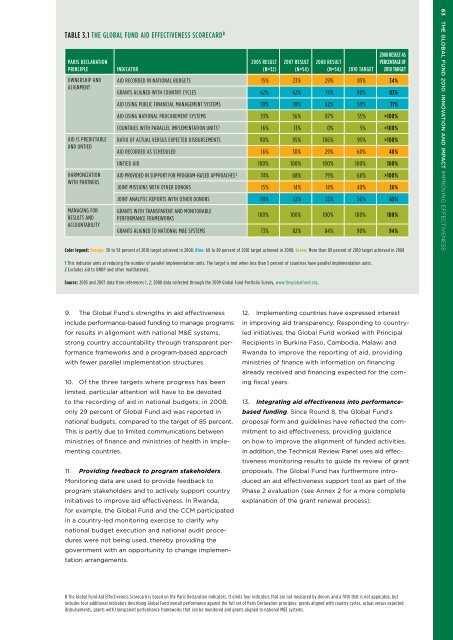Global Fund: Progress Report 2010 - unaids
Global Fund: Progress Report 2010 - unaids
Global Fund: Progress Report 2010 - unaids
Create successful ePaper yourself
Turn your PDF publications into a flip-book with our unique Google optimized e-Paper software.
TABLE 3.1 THE GLOBAL FUND AID EFFECTIVENESS SCORECARD 8<br />
PARIS DECLARATION<br />
PRINCIPLE<br />
OWNERSHIP AND<br />
ALIGNMENT<br />
AID IS PREDICTABLE<br />
AND UNTIED<br />
HARMONIZATION<br />
WITH PARTNERS<br />
MANAGING FOR<br />
RESULTS AND<br />
ACCOUNTABILITY<br />
INDICATOR<br />
2005 RESULT<br />
(N=32)<br />
2007 RESULT<br />
(N=54)<br />
2008 RESULT<br />
(N=54)<br />
<strong>2010</strong> TARGET<br />
2008 RESULT AS<br />
PERCENTAGE OF<br />
<strong>2010</strong> TARGET<br />
AID RECORDED IN NATIONAL BUDGETS 15% 23% 29% 85% 34%<br />
GRANTS ALIGNED WITH COUNTRY CYCLES 62% 62% 75% 90% 83%<br />
AID USING PUBLIC FINANCIAL MANAGEMENT SYSTEMS 39% 39% 42% 59% 71%<br />
AID USING NATIONAL PROCUREMENT SYSTEMS 33% 56% 87% 55% >100%<br />
COUNTRIES WITH PARALLEL IMPLEMENTATION UNITS 1 16% 13% 0% 5% >100%<br />
RATIO OF ACTUAL VERSUS EXPECTED DISBURSEMENTS 90% 95% 106% 95% >100%<br />
AID RECORDED AS SCHEDULED 16% 30% 29% 60% 48%<br />
UNTIED AID 100% 100% 100% 100% 100%<br />
AID PROVIDED IN SUPPORT FOR PROGRAM-BASED APPROACHES 2 74% 68% 79% 66% >100%<br />
JOINT MISSIONS WITH OTHER DONORS 15% 14% 14% 40% 36%<br />
JOINT ANALYTIC REPORTS WITH OTHER DONORS 50% 22% 33% 50% 65%<br />
GRANTS WITH TRANSPARENT AND MONITORABLE<br />
PERFORMANCE FRAMEWORKS<br />
100% 100% 100% 100% 100%<br />
GRANTS ALIGNED TO NATIONAL M&E SYSTEMS 73% 82% 84% 90% 94%<br />
Color legend: Orange: 30 to 59 percent of <strong>2010</strong> target achieved in 2008; Blue: 60 to 89 percent of <strong>2010</strong> target achieved in 2008; Green: More than 89 percent of <strong>2010</strong> target achieved in 2008<br />
63 THE GLOBAL FUND <strong>2010</strong>: INNOVATION AND IMPACT imprOviNG EFFectiveNess<br />
1 This indicator aims at reducing the number of parallel implementation units. The target is met when less than 5 percent of countries have parallel implementation units.<br />
2 Excludes aid to UNDP and other multilaterals.<br />
Source: 2005 and 2007 data from references 1, 2; 2008 data collected through the 2009 <strong>Global</strong> <strong>Fund</strong> Portfolio Survey, www.theglobalfund.org.<br />
9. The <strong>Global</strong> <strong>Fund</strong>’s strengths in aid effectiveness<br />
include performance-based funding to manage programs<br />
for results in alignment with national M&E systems,<br />
strong country accountability through transparent performance<br />
frameworks and a program-based approach<br />
with fewer parallel implementation structures.<br />
10. Of the three targets where progress has been<br />
limited, particular attention will have to be devoted<br />
to the recording of aid in national budgets; in 2008,<br />
only 29 percent of <strong>Global</strong> <strong>Fund</strong> aid was reported in<br />
national budgets, compared to the target of 85 percent.<br />
This is partly due to limited communications between<br />
ministries of finance and ministries of health in implementing<br />
countries.<br />
11. Providing feedback to program stakeholders.<br />
Monitoring data are used to provide feedback to<br />
program stakeholders and to actively support country<br />
initiatives to improve aid effectiveness. In Rwanda,<br />
for example, the <strong>Global</strong> <strong>Fund</strong> and the CCM participated<br />
in a country-led monitoring exercise to clarify why<br />
national budget execution and national audit procedures<br />
were not being used, thereby providing the<br />
government with an opportunity to change implementation<br />
arrangements.<br />
12. Implementing countries have expressed interest<br />
in improving aid transparency. Responding to countryled<br />
initiatives, the <strong>Global</strong> <strong>Fund</strong> worked with Principal<br />
Recipients in Burkina Faso, Cambodia, Malawi and<br />
Rwanda to improve the reporting of aid, providing<br />
ministries of finance with information on financing<br />
already received and financing expected for the coming<br />
fiscal years.<br />
13. Integrating aid effectiveness into performancebased<br />
funding. Since Round 8, the <strong>Global</strong> <strong>Fund</strong>’s<br />
proposal form and guidelines have reflected the commitment<br />
to aid effectiveness, providing guidance<br />
on how to improve the alignment of funded activities.<br />
In addition, the Technical Review Panel uses aid effectiveness<br />
monitoring results to guide its review of grant<br />
proposals. The <strong>Global</strong> <strong>Fund</strong> has furthermore introduced<br />
an aid effectiveness support tool as part of the<br />
Phase 2 evaluation (see Annex 2 for a more complete<br />
explanation of the grant renewal process).<br />
8 The <strong>Global</strong> <strong>Fund</strong> Aid Effectiveness Scorecard is based on the Paris Declaration indicators. It omits four indicators that are not measured by donors and a fifth that is not applicable, but<br />
includes four additional indicators describing <strong>Global</strong> <strong>Fund</strong> overall performance against the full set of Paris Declaration principles: grants aligned with country cycles, actual versus expected<br />
disbursements, grants with transparent performance frameworks that can be monitored and grants aligned to national M&E systems.

















